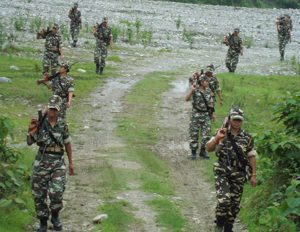India’s Northeast, once wracked by multiple insurgencies, is witnessing a marked decline in insurgency-related incidents.
According to the Ministry of Home Affairs’ Annual Report 2020-2021, “The security situation” in India’s northeastern states “improved substantially since 2014.”
“The year 2020 recorded the lowest insurgency incidents and casualties among the civilians and security forces during the last two decades,” the report said. Comparing the situation to 2014, the MHA’s latest report observed that there has been an “80% reduction in insurgency incidents in 2020.” While casualties among the security forces have dropped by 75 percent, civilian fatalities have declined by 99 percent in this period.
The report points out that while the states of Mizoram, Sikkim and Tripura remained peaceful by and large, there was “marked improvement” in the security situation in the other states of the region. In 2020, insurgency-related violence declined by 42 percent in Arunachal Pradesh, 12 percent in Assam, 23 percent in Manipur and 45 percent in Nagaland compared to 2019.
Armed insurrections in the region began with a fleeting revolt by the Shanti Sena in Tripura led by Bipulananda Kar Choudhury soon after the county gained independence in 1947. A branch of the Communist Party of India (CPI), the Shanti Sena demanded reforms in land laws and an end to the feudal regime of the erstwhile princely state in Tripura.
This was followed by the armed campaign launched by the Naga National Council (NNC) in the mid-1950s calling for an independent Nagaland. Subsequently, over the next few decades, secessionist outfits and organizations demanding autonomy became active in the other states of the region, prompting the Indian government to unleash aggressive counterinsurgency operations and the promulgation of special laws such as the Armed Forces (Special Powers) Act 1958.
A combination of many factors sustained the insurgent organizations in India’s Northeast for several decades. China and Pakistan assisted these outfits with training facilities and weapons. In addition, there were sanctuaries in the neighboring countries of Bhutan, Bangladesh and Myanmar and easy availability of weapons.
India’s Northeast, which is landlocked and flanked by China, Bhutan, Bangladesh and Myanmar, is one of the most underdeveloped regions in the country. A large proportion of its youth is unemployed. These unemployed youths swelled the ranks of these outfits for many decades.
The situation began changing in 2003 when Bhutan launched a military offensive to dismantle the camps and training centers of three militant outfits active in Assam and West Bengal.
Five years later, a crackdown began in Bangladesh resulting in the capture of top rebel leaders. They were handed over to India.
In 2019, some camps in Myanmar’s Sagaing Division were also eradicated by the Myanmar military although there are reports that regrouping of these outfits has begun again in the region.
In the Northeast, the Indian government has been following a carrot and stick policy, which has involved offers of negotiations to all armed outfits alongside pursuit of counterinsurgency operations. Rebel groups have entered into peace agreements with the government at regular intervals preceded by periods of ceasefire and submission of charters of demands.
Last year, five militant outfits in Assam returned to the mainstream after inking accords with the government.
A surrender policy was unveiled by the government in 1998, which was revised ten years later. Under this policy, a surrendered militant functionary is granted Rupees 400,000 (approximately $5,000), a monthly stipend of Rs 6,000 for three years, and vocational training for self-employment. Thousands of functionaries from all the northeastern states have availed the package over the past several years.
Currently, around 40 insurgent outfits are active in the Northeast in as many as six out of the region’s eight states. Manipur has the maximum number of active insurgent groups, while Sikkim and Mizoram have almost none.
These groups can be broadly divided into five categories with the largest number being outfits engaged in a peace process with the government with the goal of clinching a negotiated settlement. This category includes the Isak-Muivah faction of the National Socialist Council of Nagalim (NSCN-IM), pro-talks faction of the United Liberation Front of Asom (ULFA) and over 20 outfits in Manipur belonging to the Kuki and Zomi communities.
Besides this category, there are seven secessionist outfits that have camps and investments in Myanmar. They have spurned the offer of talks with the Indian government and continue to engage in intermittent attacks against the security forces.
In the past couple of years, the security forces have successfully busted modules of the Communist Party of India (Maoist) in Assam and terror outfits in Bangladesh affiliated with al-Qaida. There are also smaller groups that surface and fizzle out from time to time in areas such as Assam’s twin hill districts of Karbi Anglong and Dima Hasao that were among the most disturbed in the region.

































